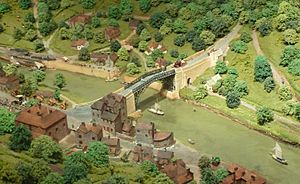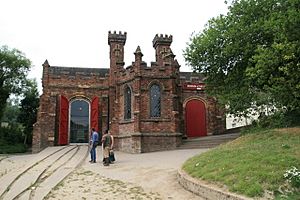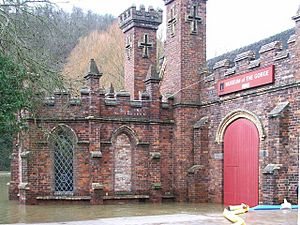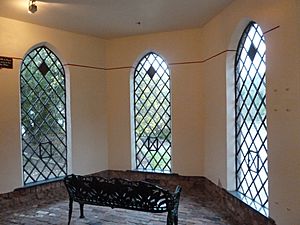Museum of the Gorge, Ironbridge facts for kids
The Museum of the Gorge is one of ten museums in the Ironbridge Gorge. It teaches visitors about the history of this special area. The museum is located in Shropshire, England. It was once a large building called the Severn Warehouse.
Contents
History of the Severn Warehouse
The River Severn was very important for transport long ago. Before trains, boats called 'Severn trows' used the river. They brought raw materials to the factories in the Gorge. They also carried finished goods away.
The river's water level changed a lot with the seasons. In summer, the water was too low for boats. So, finished products were stored in warehouses. They waited there until the river had enough water again.
The warehouse was built around 1840. It was designed for the Coalbrookdale Company. The architect was Samuel Cookson. The building looks very unique for a warehouse. It has a Gothic Revival style. This style was popular at the time.
The warehouse has a special roof with pointed decorations. One side looks like a church. It has tall, narrow windows. These windows let in light for the office inside. The building is made of red brick with yellow brick details.
The warehouse is a very important historical building. It is listed as Grade II*. The old stone walls of the wharf next to it are also listed. These walls were built in the 1780s.
Small tramways were used around Coalbrookdale. Grooves for these tramways can still be seen in the paving. They led from the warehouse doors to the river.
Later, more warehouses were built nearby. These buildings were used for light industry. At one time, the Merrythought teddy bear factory was located there.
Flooding at the Warehouse
Flooding has always been a challenge for this part of the river. The warehouse often experiences floods each year. The highest flood ever is marked by a painted line inside the building. It is almost at the top of the windows.
What You Can See at the Museum
The Museum of the Gorge helps visitors understand the whole Ironbridge Gorge area. Films and interactive displays explain its history.

There are not many exhibits about the warehouse building itself. But you can see examples of iron goods. These are the kinds of products that the Coalbrookdale Company made. They would have been shipped from this very warehouse.
The Iron Bridge Diorama

The main attraction at the museum is a huge diorama. It is about 12 meters (40 feet) long. This model shows the entire Gorge during its busiest industrial period.
The diorama shows King George III visiting the Iron Bridge in 1796. The bridge had opened 15 years earlier. At this time, Britain was at war with France. The industries in the Gorge were very important for the country.
In the early days of the Industrial Revolution, the Gorge had many small factories. There were also many small bell pits. These were shallow mines for digging coal. They used horse gins to lift things. You can see models of these on the diorama.
One of the largest parts of the diorama shows the Hay Inclined Plane. This was part of the Shropshire Canal. It was opened in 1792. Boats were moved up and down this slope. At the bottom was the Coalport Canal and the Coalport China factory. This factory opened in 1795.
The diorama is a great way to see how the Ironbridge Gorge looked long ago. It helps visitors plan their trip to the other museums and sites in the area.
See also
- Listed buildings in The Gorge




